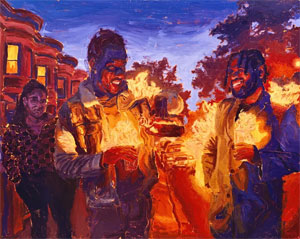5.8.24 — Start the Fire
To pick up as promised from last week, African American art has never looked better. The sheer amount of portraiture today reflects the wealth of possibilities and its increasing acceptance in the galleries.
With the Dean collection at the Brooklyn Museum, the Obama state portraits, or such artists as Henry Taylor at the Whitney, one can almost take it for granted or as a right. More than ever, too, that acceptance extends to black abstraction.  Sam Gilliam, Melvin Edwards, and William T. Williams are no longer a niche or in need of recovery, but at the very center of the action—to the point that such younger artists as Odili Donald Odita have to fight for space. Even apart from photography, video, echoes of Africa, and overtly political art, here all art is both personal and political.
Sam Gilliam, Melvin Edwards, and William T. Williams are no longer a niche or in need of recovery, but at the very center of the action—to the point that such younger artists as Odili Donald Odita have to fight for space. Even apart from photography, video, echoes of Africa, and overtly political art, here all art is both personal and political.
So at least runs one decent enough story, but consider another. Actual political art is shunted aside, because too many artists I do not care to name cannot get off their high horse. Portraiture looks less and less real and less human because they cannot let go of the glitter. They are so proud of their identity that the tensions inherent in the label are kept behind the tapestry and shoveled under the rug. They are painting not individuals now, but icons. They may pull their subjects from the street, but the fire of the streets is gone.
Could both stories be true? If so, it could attest after all to a vibrant, thought-provoking state of the art. At least one young artist is back on the streets as well. He is also challenging himself and others as to who owns the streets and who gets to enjoy them. At the end of the day, and Alexander Brewington loves the night, he and his friends can stand tall and take it easy. Hey, they didn’t start the fire.
As we saw last week, Arthur Jafa titles his video with a row of asterisks, like something unprintable. This artist spells out no more than he must, while articulating the feelings of others. In the past he has wrapped a huge tire in chains, but he is not just out to run you over. He titles the second installation (with its typo), Black Power Tool and Die Trynig. He brings irony to his own hopes for black power, and he knows what it means to die. He knows, too, when to walk away.
Then again, it can be hard to name the streets and harder still to call them a community. Fresh from his MFA at Pratt, Brewington is walking Manhattan, including midtown Manhattan, where not everyone can afford a drink. Even with the Chrysler Building visible at the end of a street, I could not pin down the neighborhood. Two friends share drinks at one bar, but others at the window are looking in, perhaps never to arrive. So much for Brooklyn or Harlem with their true communities, although stone row houses may equally well belong to them.
In “What Burns Beneath,” the streets sure look familiar, at Thierry Goldberg earlier this year through March 16. Black or white, you can recognize the trains as New York and the entrance to the Williamsburg Bridge as a landmark. Inside, well-stocked bars could make anyone feel at home. Those walking the streets or hanging out for a drink might already be your friends. At the very least, they look like individuals. Warm-weather coats and frank expressions replace fine art’s idea of street clothes.
At the same time, the fire has spread. Paint on board from Brewington has visible highlights dribbling along the edges. Less explicable pools of yellow and orange cluster and rise, from the pavement or in windows, whether as comforts or as threats. While two men seem to be warming their hands, in Flambé, the flames may or may not be real. Others might want to keep their distance, perhaps even Jafa’s taxi driver. It is all part of life in the city.
Read more, now in a feature-length article on this site.